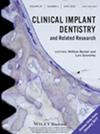The Effect of Angulation and Scan Body Position on Scans for Implant-Treated Edentulism: A Clinical Simulation Study
Abstract
Introduction
The acquisition of digital impressions has become an integral part of clinical dentistry. The purpose of the present clinical simulation study was to evaluate the accuracy of digital impressions for maxillary full-arch implant-supported prostheses using two modern intraoral scanners with different acquisition technologies.
Material and Methods
Two models of edentulous maxilla, with six implants at positions #16,14,12,22,24,26 (FDI World Dental Federation System, ISO 3950) or #3,5,7,10,12,14 (Universal Numbering system) were digitally designed, and 3D-printed in resin material (Asiga DentaMODEL, Australia). In the first scenario, all implants were parallelized, while in the second, implants #12/#7 and #22/#10 had a 20° angulation buccally, while implants #16/#3 and #26/#14 20° angulation distally. The models were scanned with two different intraoral scanners, Trios3 (3Shape, Denmark) and CS3600 (Carestream Dental, USA). Linear (x, y, z axes—top point) and angular deviations (x, y, z axes—Δφ) were assessed. Statistical analysis was performed using Kolmogorov–Smirnov tests (significance at p < 0.05).
Results
Implant angulation showed a significant impact on accuracy, while the two scanners showed statistically significant differences. CS3600 demonstrated superior trueness, while Trios3 superior precision in both clinical scenarios. In the first clinical scenario a predominant occurrence of angular deviations was observed, while in the second scenario both angular and linear deviations were recorded. Scan body position also influenced scanning outcomes, with the last scan body captured demonstrating higher deviations.
Conclusion
Both scanners provided acceptable accuracy in the acquisition of digital impressions. Implant angulation and scan body position significantly affected trueness and precision. Clinicians should carefully consider implant angulations in full-arch implant restorations, as well as the scanning protocol.


 求助内容:
求助内容: 应助结果提醒方式:
应助结果提醒方式:


